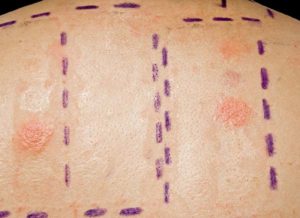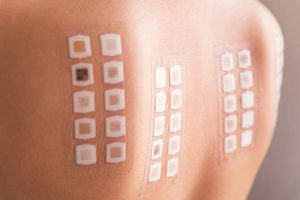Patch Testing
What is Patch Testing?
 Patch testing helps to confirm a diagnosis of an allergic contact dermatitis, which is a type of skin rash that occurs when certain substances come in contact with the skin. Examples of these substances are fragrance in perfume, adhesives used in bandages, metals found in jewelry, and glues used in shoes, just to name a few. Click here for a patch testing handout.
Patch testing helps to confirm a diagnosis of an allergic contact dermatitis, which is a type of skin rash that occurs when certain substances come in contact with the skin. Examples of these substances are fragrance in perfume, adhesives used in bandages, metals found in jewelry, and glues used in shoes, just to name a few. Click here for a patch testing handout.
Anyone can develop skin irritation (also called an irritant contact dermatitis) when exposed to harsh chemicals like strong detergents, household cleansers, solvents, and acids. However, reactions to allergens are different. Not everyone will develop an allergic contact dermatitis when exposed to allergens. That’s why you may be the only person you know that experiences a rash when coming in contact with a particular allergen. Allergic contact dermatitis can only occur after the immune system cells in the skin learn to recognize the allergen and become activated to cause inflammation. In some cases it may take just a few exposures to the allergen for this sensitization to occur. In other cases, sensitization occurs only after years of repeated exposure, which explains why a new allergy can develop to a product that you have used for months or years without any previous difficulty.
How is Patch Testing Performed?
 Strips of tape containing small quantities of common allergens will be applied to the skin of your back during your first visit. Their is a standard panel called the TRUE test. Items can also be brought from home. The allergens must remain in place and be kept dry for 48 hours.
Strips of tape containing small quantities of common allergens will be applied to the skin of your back during your first visit. Their is a standard panel called the TRUE test. Items can also be brought from home. The allergens must remain in place and be kept dry for 48 hours.
After the 48 hours, the patches will be removed and an initial reading will be performed. The patch sites w/ill be outlined with a marker, and you will be asked to return for a final reading on another day. A positive test will show a red, raised area of skin, often with itching. A strong reaction could cause blistering and, very rarely, a prolonged reaction (lasting several weeks) or scarring.
How Can I Increase the Reliability of the Test?
- Keep the skin of your back dry until the patches are removed 48 hours after applied. Until then, no showering, bathing (except for sponge baths), or swimming.
- Avoid any activity that may cause you to sweat heavily (examples: exercising, shoveling). Excessive perspiration could cause the patches to fall off.
- If any of the patches begins to peel loose, reinforce it with adhesive tape.
- Do not remove/wash the magic marker markings on your back until instructed to do so. Some of the ink sometimes does come off on clothing, so it may be a good idea to wear a dark undershirt.
Boise Valley Asthma and Allergy Clinic – We are always here for you
Your BVAAC board-certified allergist is well trained and experienced in all aspects of patch testing. If you wonder whether you or a member of your family needs patch testing, give us a call today at 208-378-0080 or click the button below to make an appointment request online.